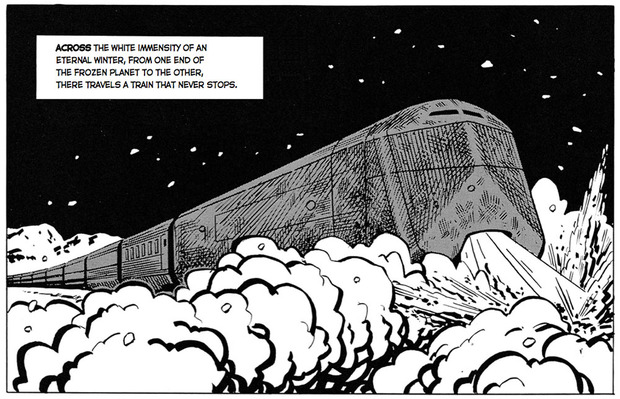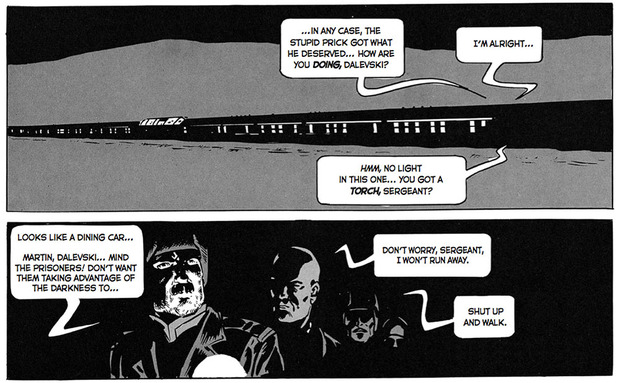Snowpiercer: The Escape
The French sci-fi graphic novel, whose film adaption will soon release in the US, finally gets its English translation 30 years later


The 1982 French sci-fi comic “Le Transperceneige” would have remained in obscurity had film director Bong Joon-Ho not walked into a comic book shop in Seoul and devoured all three volumes in the store. Nobody could blame him. Within the black-and-white illustrations, a post-apocalyptic world, frozen over by ice and snow, is revealed. The only human survivors are aboard a train—the Snowpiercer—that perpetually circles the planet. Class segregation still exists aboard the Snowpiercer, and the inequality between the elite (who live closer to the engine and in comfort) and those who live at the tail-end in poverty is stark. There are no superheroes here, just people trying to stay alive, along with one who dares to unravel the mysteries of the train.

An internationally acclaimed Korean director and screenwriter, Bong is behind films such as “The Host” and “Mother” which blend social and political commentary with emotional plot twists that keep audiences at the edge of their seats—while balancing the mood with occasional comedic moments. Similarly, Bong transformed the graphic novel into the hit film “Snowpiercer,” featuring an international cast including Chris Evans, an almost unrecognizable Tilda Swinton, Ed Harris, Octavia Spencer, as well as Song Kang-ho and Ko Ah-sung, two of Bong’s regular collaborators. Although “Snowpiercer” was released last August in Korea (and later, throughout Asia and France), breaking box office records along the way, its release date in the rest of the world is still uncertain. The Weinstein Company bought the rights in North America, the UK, Australia and more but discussions over recuts have delayed the process, and set off a bit of a media flurry.

Other than a French translation, the book had only been available in the Korean language—a great stroke of luck for Bong—but thanks to the film’s success, English speakers will now get to experience the novel for the first time through the translation from Titan. The original writer Jacques Lob (famous for his Superman parody comic “Superdupont”) passed away in 1990, we spoke with French artist Jean-Marc Rochette and writer Benjamin Legrand, who continued the series, to learn more about the timeless story.

Jean Marc, how did you meet Jacques Lob to collaborate on the first “Le Transperceneige” book?
Rochette: I met Jacques Lob in 1981, when he was looking for a designer for “Le Transperceneige.” He wrote a first version of this story in 1976 for another artist, Alexis, who unfortunately died in 1977. Alexis’ first version was much less pessimistic, and more poetic. I was surprised to be chosen, as I was very young (only 25 years old), known mostly for my underground comics like Edmond le Cochon, a kind of French “Fritz the Cat,” and without experience of realistic drawing. I think Jacques Lob had noticed my ability to work facial expressions. It was a very hard job for me at that time, because the story is always held in the same place—a very narrow space, a train.
What stylistic choices did you make in regards to the apocalyptic setting of the future? What was the most difficult aspect of the story to illustrate?
Rochette: The challenge was not to be boring. My inspiration for this story was mostly two films: Godard’s “Alphaville” and “The Trial” by Orson Welles. I did not want the design to be too “futuristic” but rather to be set in an indeterminable time.

Benjamin, what is your background as a writer?
Legrand: I started working as an assistant director in film business. I played in a rock group, travelled a hell of a lot, wrote eleven novels (mostly thrillers and Science Fiction), six long feature movies for the cinema, a few dozens TV series episodes—both in live action or animation (I even directed some)—and translated about 40 American and English novels. And, of course I wrote several stories for comics, mostly thrillers and sci-fi.

What happened in between the 15 years of the first and second book? What inspired you to continue the series?
Legrand: Jean-Marc and I, we met right after he finished drawing “Le Transperceneige” for Jacques Lob. In those days, I’d just finished my first story for a comic book with Tardi, called “The Cockroach Killer” (a thriller taking place in Manhattan and the Bronx). Jacques Lob was also a friend of mine, and me being younger than him, to me he was a master in storytelling. The two stories were published in A SUIVRE (“To Be Continued”)—a very famous comics magazine—and Jean-Marc and I, we met at our publisher’s office. It was the beginning of a long collaboration. We did three graphic novels together. Almost 10 years after Jacques Lob passed away, Jean-Marc had the idea to create a sequel to “The Snowpiercer,” so that Jacques Lob’s masterpiece would live again. My main problem was that the end of “Le Transperceneige” was very closed! But then came the idea of a second train; bigger, more modern, and in which the inhabitants lived in the fear of a frontal crash with the first Transperceneige, running on the same tracks all around the world.
Rochette: “Le Transperceneige” lost its audience over the years; it sank into oblivion. It was a pity and I thought about a sequel, and as I knew that Benjamin had worked on an adaptation of “Le Transperceneige” for a film, which was approved by Jacques Lob, I called him. For a long time I used to doubt the choice to do a sequel for this book, but now I know that it was a good decision, because without this sequel, the “Le Transperceneige” would probably never have been published in Korea, and the film by Bong Joon Ho would never have existed.

What was it like to see the film? Did you give any suggestions or advice when they were writing the screenplay and filming?
Legrand: It was such a deep emotion, it’s really hard to express. It was like facing an incredible alchemistic achievement. The story was there and yet it was different, the pictures were there; magnified. It was the books and it was totally different at the same time, due to the huge talent of Director Bong. He took the essence of it all and he did what he wanted with it. And, in my opinion, his film is a masterpiece.
I just read the screenplay and straight off, I thought that this movie would be striking. Then I was invited on the set in Prague, and I made a cameo with Jean-Marc— [as] two people from the tail [of the train]!
Rochette: I have had, of course, no influence on the writing of Bong Joon Ho, even if I think I’m able to draw correctly sometimes, writing interests me less. I like to give the main ideas for my books, but I like to work with real screenwriters to write the story. It is not easy to be Alan Moore! But Bong Joon Ho made me participate in his film by creating the character of the painter, a sort of historian of the poor, and he asked me to create the designs you see sometimes on screen. He just instructed me that they should be dirty and wild.
The English translation of “Le Transperceneige” releases tomorrow, Tuesday 28 January, in hardcover format as “Snowpiercer: The Escape.” It’s available for $20 from Titan Comics, as well as Amazon. Titan will be releasing the second and third volumes over the next few months.
Film image courtesy of Moho Films, all other images courtesy of Titan Books












